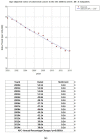Evaluation of Colorectal Cancer Incidence Trends in the United States (2000-2014)
- PMID: 29385768
- PMCID: PMC5852438
- DOI: 10.3390/jcm7020022
Evaluation of Colorectal Cancer Incidence Trends in the United States (2000-2014)
Abstract
Colorectal cancer (CRC) incidence rates have declined in recent years for people of all races/ethnicities; however, the extent to which the decrease varies annually by demographic and disease-related characteristics is largely unknown. This study examines trends and annual percent change (APC) in the incidence among persons diagnosed with CRC in the United States of America from 2000-2014. The data obtained from the National Cancer Institute's Surveillance, Epidemiology, and End Results (SEER) Program were analyzed, and all persons (N = 577,708) with malignant CRC recorded in the SEER 18 database from 2000 to 2014 were characterized according to sex, race, age at diagnosis, disease site and stage. Incidence rates and APC were calculated for the entire study period. Overall, the incidence rate of CRC decreased from 54.5 in 2000 to 38.6 per 100,000 in 2014, with APC = -2.66 (p < 0.0001). Decline in rates was most profound between 2008 and 2011 from 46.0 to 40.7 per 100,000 (APC = -4.04; p < 0.0001). Rates were higher for males (vs. females; rate ratio (RR) = 1.33) and for blacks (vs. whites; RR = 1.23). Proximal colon cancers at the localized stage were the predominant cancers. An increase in rate was observed among people younger than 50 years (6.6 per 100,000, APC= 1.5). The annual rate of CRC has decreased over time. However, the development and implementation of interventions that further reduce the disparities among demographic and disease-related subgroups are warranted.
Keywords: Colorectal cancer; SEER; annual percent change; incidence; rates.
Conflict of interest statement
The authors declare no conflict of interest. The funding sponsors had no role in the design of the study; in the collection, analyses, or interpretation of data; in the writing of the manuscript, and in the decision to publish the results.
Figures




References
-
- United States Cancer Statistics Working Group 1999–2013 Incidence and Mortality Web-Based Report. [(accessed on 8 May 2017)]; Available online: http://www.cdc.gov/uscs.
-
- American Cancer Society . Colorectal Cancer Facts & Figures 2017-2019. American Cancer Society; Atlanta, GA, USA: 2017. [(accessed on 8 May 2017)]. Available online: https://www.cancer.org/content/dam/cancer-org/research/cancer-facts-and-....
-
- Division of Cancer Prevention and Control, Centers for Disease Control and Prevention 2016. [(accessed on 8 May 2017)]; Available online: https://www.cdc.gov/cancer/colorectal/basic_info/risk_factors.htm.
Grants and funding
LinkOut - more resources
Full Text Sources
Other Literature Sources

